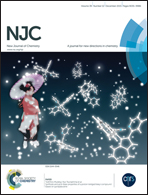A new pyrazolyl dithioate function in the precursor for the shape controlled growth of CdS nanocrystals: optical and photocatalytic activities†
Abstract
The dithiocarbazate functionalized 3,5-dimethyl pyrazole ligands and their cadmium(II) complexes e.g., [Cd(mdpa)2Cl2] (where mdpa is the methyl ester of 3,5-dimethyl pyrazole-1-dithioic acid) and [Cd(bdpa)2Cl2] (where bdpa is the benzyl ester of 3,5-dimethyl pyrazole-1-dithioic acid) have been synthesized. The complexes are used as single-source precursors (SPs) for the synthesis of spherical and rod-like CdS nanocrystals in a solvothermal process without using any external surfactants. In situ generated thiols (CH3SH in the case of the mdpa complex and PhCH2SH in the case of the bdpa complex) in thermolysis of the SP govern the growth of nanocrystals. The spherical and rod shaped CdS nanocrystals are produced in the presence of CH3SH and PhCH2SH, respectively. A possible growth mechanism of nanocrystals based on the preferential thiol bonding to the nucleus is discussed. The nanocrystals were characterized by X-ray diffraction (XRD), transmission electron microscopy (TEM), high resolution transmission electron microscopy (HRTEM) and X-ray photoelectron spectroscopy (XPS). The UV-Vis spectroscopic studies of CdS nanocrystals show the quantum confinement effect with a band gap of 2.2 eV to 2.6 eV, and the narrow intense PL emissions of the samples are red-shifted (λmax = 570 nm) due to trap-related electron–hole recombination. The CdS nanocrystals are successfully applied in the photodegradation of rose bengal (RB) and methylene blue (MB) dyes under visible light.


 Please wait while we load your content...
Please wait while we load your content...